Gmail Filters 101: Your Definitive Guide To Gmail Filters

Table of contents
Decluttering and organizing your inbox is a great idea, but it still requires a considerable amount of time and effort. However, if you use Gmail, a simpler alternative is to set up labels and filters to manage your Gmail inbox better.
We’ve written about Gmail labels earlier, so in this blog post, we’ll focus on how to use Gmail filters to sort your emails automatically.
Table of Contents
- So, what are Gmail filters?
- Actions that can be performed using Gmail filters
- How do you create a filter in Gmail?
- Precise filters with operators
- Must-have Gmail filters
- Editing or deleting filters
- Advanced Gmail filters
- Advanced filter actions
- More ways to organize your inbox
- Conclusion
So, what are Gmail filters?
Filters in Gmail are automation rules that allow you to redirect emails as they hit your inbox, thereby saving you the trouble of having to sort and manage emails manually.
For instance, you can redirect certain newsletters from certain senders into a separate inbox or directly send emails from certain sources to the trash. In Gmail, you can even use filters to add importance markers and labels of different types and colors. By weeding out emails this way, you can free up space, reduce stress levels, and focus on the conversations that really matter.
Actions that can be performed using Gmail filters
Here’s a quick run-down of all of the actions that you can perform with Gmail filters:
- Skip the inbox: Archive an email so that it doesn’t appear in your inbox.
- Mark as read: As the name suggests, have an incoming email already marked as ‘read.’
- Star it: Have Gmail mark the email as starred.
- Apply a label: Add a specific Gmail label to an email.
- Forward it: Automatically forward an email to another email address.
- Delete it: Send an email to the trash.
- Never send it to Spam: Tell Gmail to never send a specific set of emails to Spam.
- Mark important: Automatically mark a specific set of emails as important.
- Never mark it as important: Tell Gmail to never mark filtered emails as important.
- Categorize as: If you use multiple categories of inboxes such as Primary, Social, Updates, etc., tell Gmail to automatically add a specific set of incoming messages under a category.
How do you create a filter in Gmail?
There are two ways of creating filters in Gmail.
Method 1: Using the search bar

Go to the Gmail search bar, type in a keyword or specific email address you’d like to filter out, and click on the filter symbol.

Clicking on the filter symbol opens up a dropdown. This dropdown allows you to further refine your filter conditions. Once you’ve done that, click on the “Create filter” option.

You can now choose what you want this filter to do. For instance, in this case, I’d like to have all emails that contain the keyword “News” and are from Google Newsletter’s email address, <[email protected]>, go into my Updates folder instead of my primary inbox. So I click the dropdown next to the “Categorize As” option and select “Updates”.

Clicking on the “Create filter” button will now create the said filter, and all emails which contain the keyword “News” and are from the email address <[email protected]> will now appear in my “Updates” folder instead of my primary inbox.
Pro tip: Remember to click on the “Also apply a filter to matching conversations” checkbox. This way, all your pre-existing emails that match the filter conditions will also be included within the filter conditions.
With this, you have created your first Gmail filter and are on your way to achieving email nirvana.
Method 2: Create a filter from the settings menu in Gmail
Click on the ‘gear icon’ on the top right of your Gmail screen.
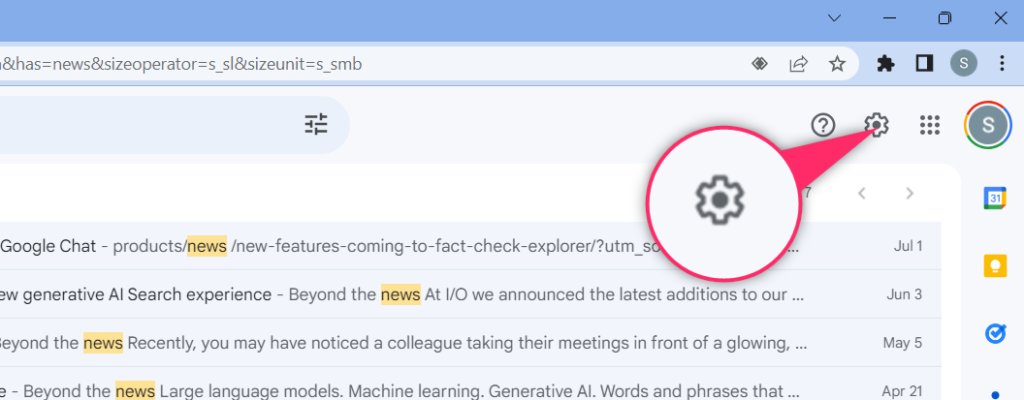
Pick “See all settings” at the top.

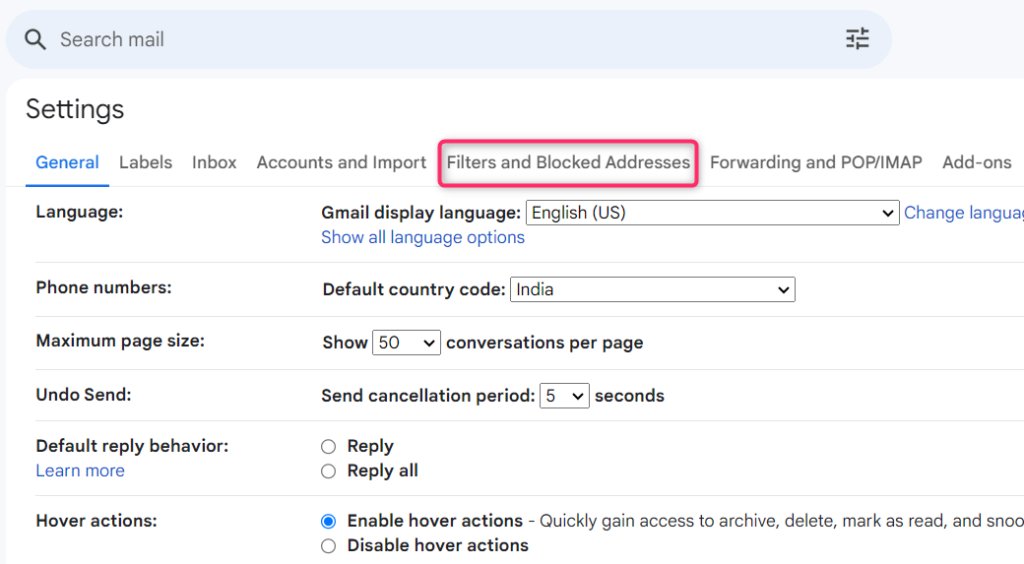
And then click on ‘filters and blocked addresses.’ This section shows you the existing Gmail filters which are applied to your Google account.
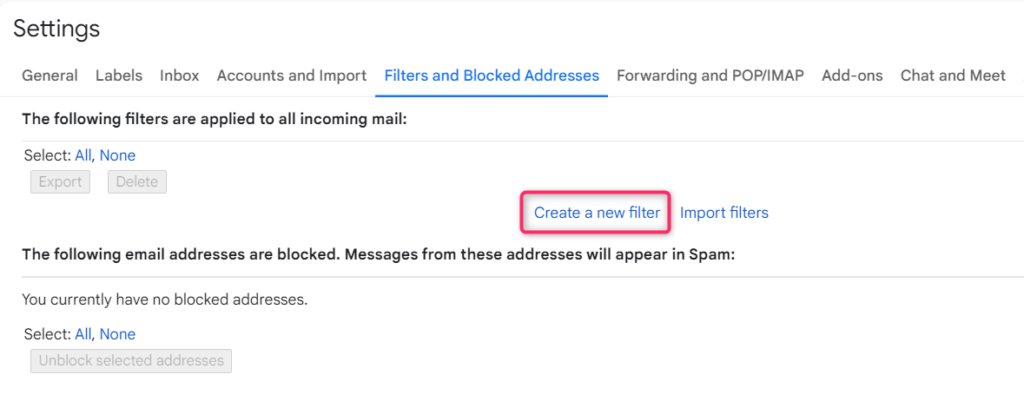
To create a new filter, click on the “Create a new filter” option.

This opens up a dropdown menu, which, if you’ve read through the previous section, looks familiar.
The rest of the steps to create the filter remain the same as in the previous section.
Method 3: Directly from an Email
Open the email that you wish to filter and click on the three vertical dots in the top right corner.
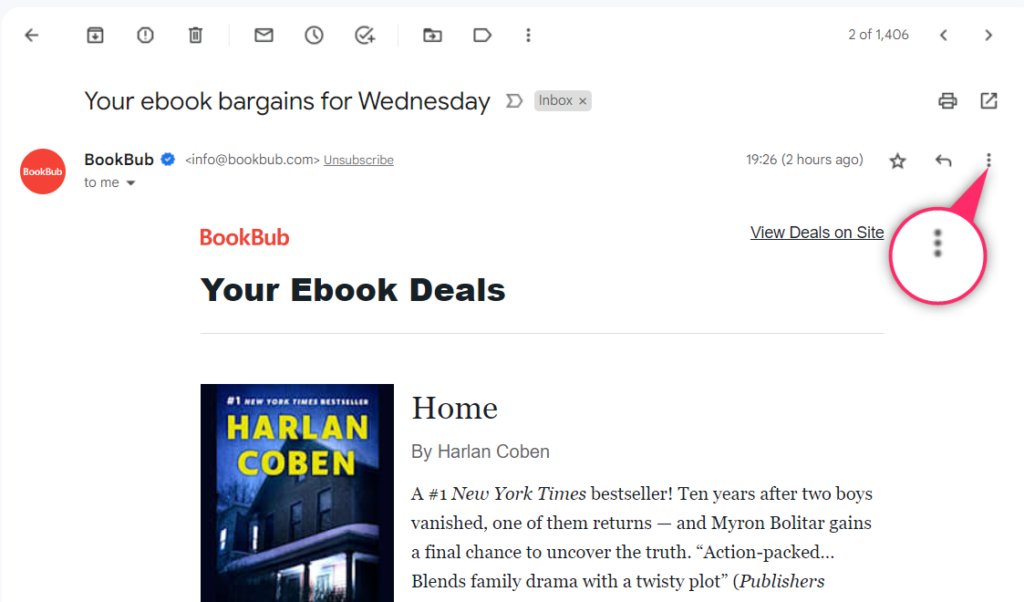
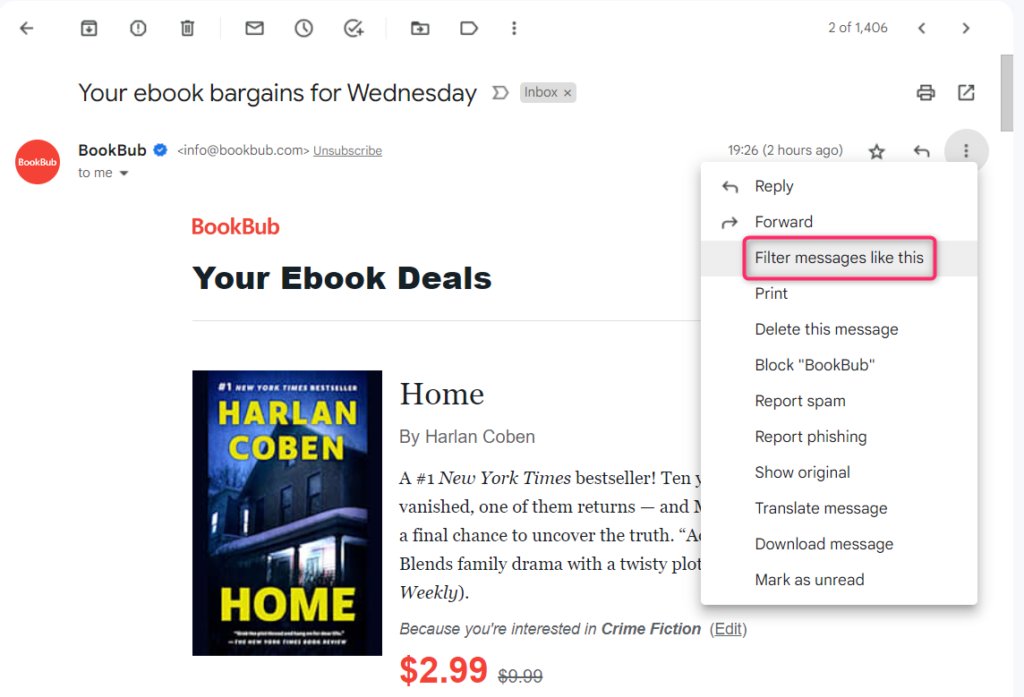

Precise filters with operators
Gmail supports several operators which allow you to perform precise search operations. These searches can then be saved as powerful and precise filters. Here’s a quick run-down of the operators that are supported by Gmail and their functions.
| Operator | Meaning | Use Case |
|---|---|---|
| or | Combines two or more filters with an OR operator. | is: from your boss’s email address or is:from your colleague’s email address |
| and | Combines two or more filters with an AND operator. | is: from your boss’s email address and is:in the subject “invoice” |
| ( ) | Groups together multiple filters. | (is: from your boss’s email address or is:from your colleague’s email address) and is:in the subject “invoice” |
| + | Includes the specified word or phrase. | has:the words “invoice” “payment” +unsubscribe |
| – | Excludes the specified word or phrase. | has:the words “invoice” “payment” -unsubscribe |
| * | Matches any number of characters. | has:the words “invoice” payment |
Must-have Gmail filters
1. Auto-delete unwanted emails
Preventing emails from reaching your inbox is a hundred times better than having to deal with them once they enter your inbox. You can always use Gmail’s block button or even a smart tool like unroll.me
But sometimes you come across spam email senders that don’t honor your unsubscribe requests or senders you can’t block even if you’d like to. Or maybe you find pesky emails that get past your gmail spam filters and end up in your inbox.
One way to get around those is by using a filter. You can:
- Create a filter based on the sender’s email address, and then,
- Instruct Gmail to delete those emails.
2. Mark emails as read
All emails are equal, but some are more equal than others. This is why it is important to mark these less important emails as ‘read’ so that you can focus on the ones that really matter.
Once again, you can:
- Create a filter based on the sender’s email address or keywords and then
- Instruct Gmail to ‘mark as read.’
3. Move emails to specific categories
If you aren’t using Gmail’s tabbed inboxes, you probably should. Tabbed inboxes allow you to segregate your inbox into tabs such as Primary, Social, Updates, etc., allowing you to focus on emails that matter.
To enable tabbed inboxes, click on the ‘gear icon’ on the top right corner of your Gmail window and click on ‘Configure inbox’ from the dropdown.
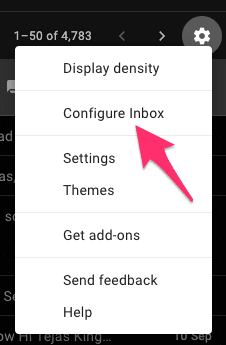
Now click on the tabs you want to enable and hit save.
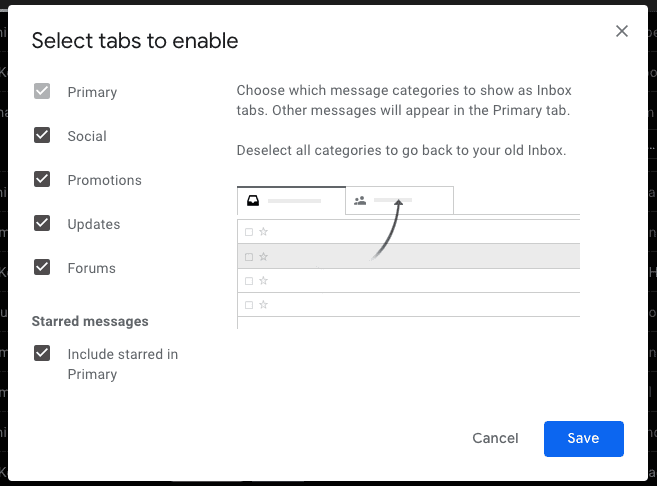
In order to do that, you can:
- Create a filter based on the sender’s email address or keywords and then,
- Choose the filter action, ‘Categorize as’ and have Gmail move the filtered emails under a specific tab in your inbox.
4. Automatically add labels to emails
We’ve already spoken about how Gmail labels are a powerful tool to organize your inbox. You can read more about it here. You can use filters to automate label creation so that you can mark certain emails as important, or for follow-ups, etc.
To automate label creation:
- Create a filter based on the sender’s email address or keywords and then,
- Use the ‘Apply a label’ and pick a label from the dropdown menu.
- Go to the Gmail search bar and click on the gray triangle.
- In the dropdown, navigate to the “Has the words” field and type in is:spam.
- Click on the “Create filter” button.
- Use the “Delete it” filter action and confirm filter creation.
Editing or deleting filters
To edit or delete a filter, follow the same set of steps as above, ie. gear icon→settings→filters and blocked addresses.
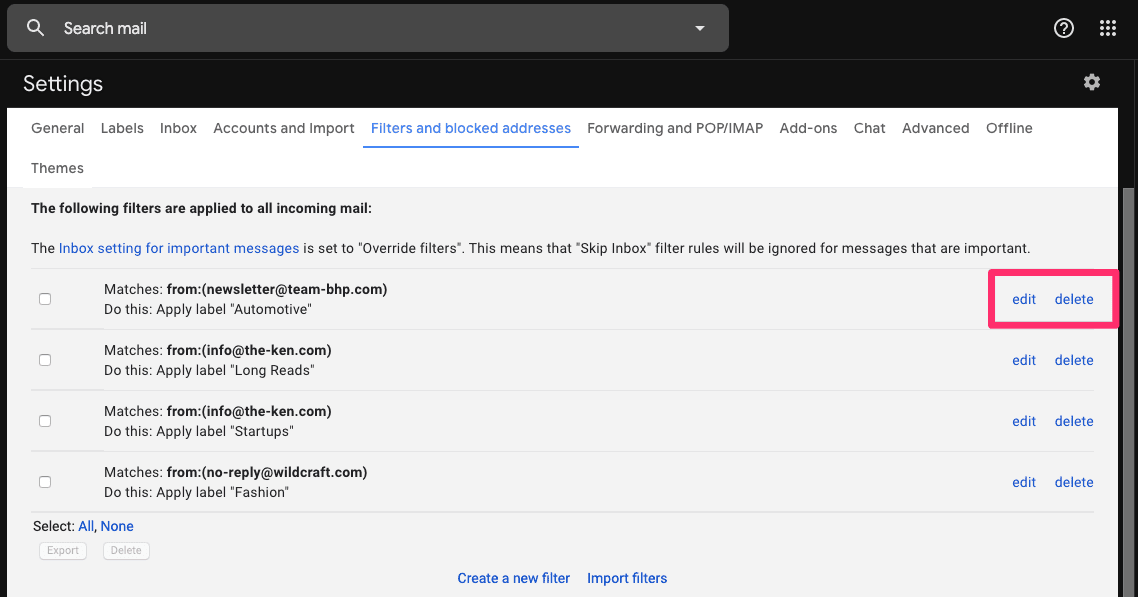
This now shows you a list of all your existing Gmail filters. In addition to this, next to each filter, you see an option to either edit the filter or delete it.
Clicking on ‘edit’ opens up a dropdown menu that allows you to refine your filter conditions.
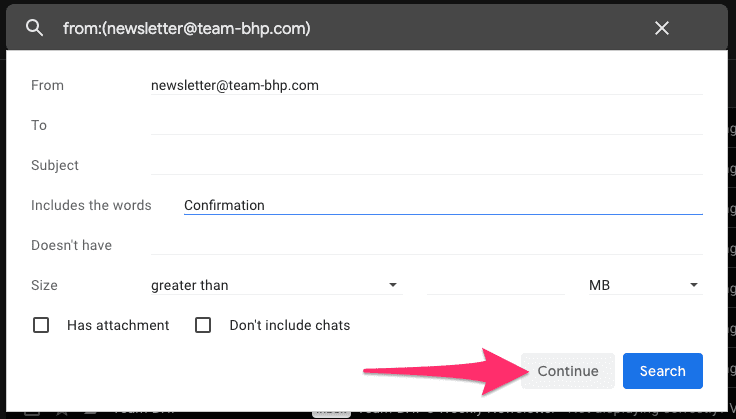
For instance, I’ve now modified the filter and added a condition to filter emails containing the keyword ‘Confirmation.’ Clicking on ‘Continue’ takes you to the next dropdown which then allows you to modify the actions you want the filter to take.
For instance, in this case, the filter was used to add a label to an email. I’m now using it to also send emails that contain a particular keyword to the trash.
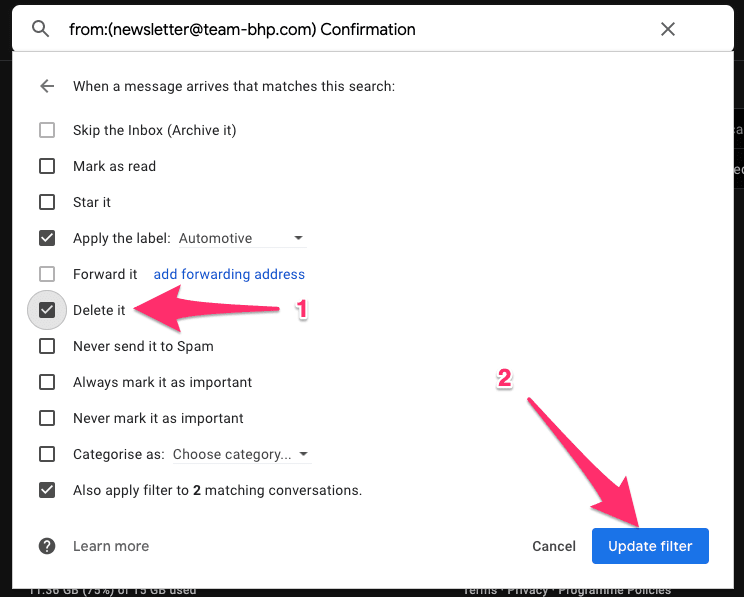
Clicking on ‘Update filter’ edits the filter conditions.
Deleting a filter is simple. Simply click on the ‘delete’ option next to the filter you wish to delete, confirm that you wish to delete the filter you have selected and you’re all done.
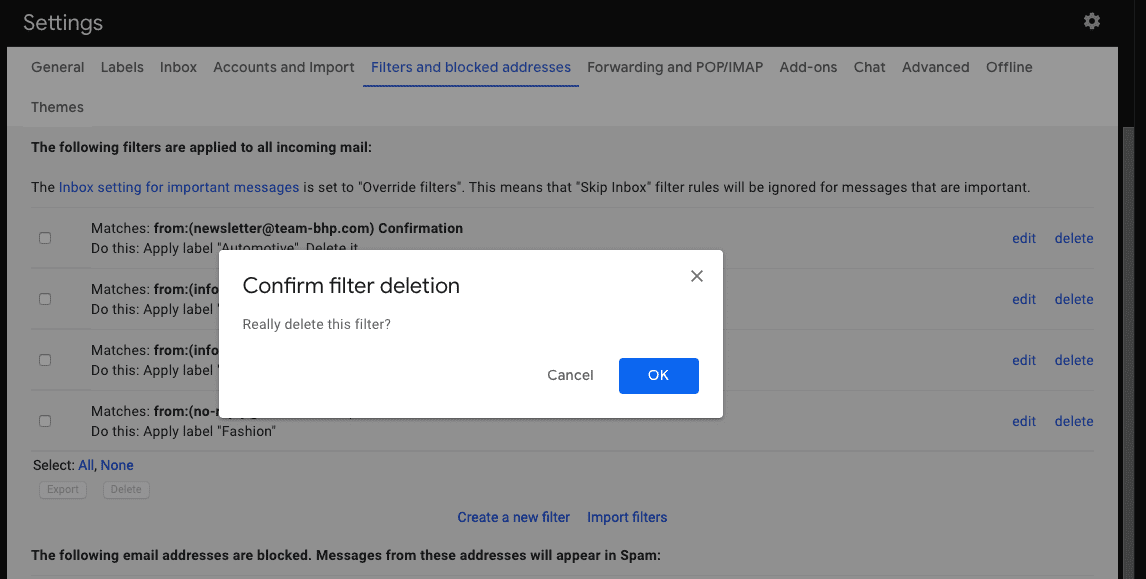
Pro-tip: Gmail allows you to take bulk actions on filters. Use the checkboxes on the left-hand side columns of the filters and choose one, many, or all of the filters.
Recommended Read
How to Use Gmail as a Helpdesk
Advanced Gmail filters
While basic filters might sort emails from a specific sender or with a particular subject line, advanced filters allow you to use a combination of multiple conditions to control how your emails are handled precisely. Here’s how advanced filters can be utilized:
1. Combine multiple criteria for precise filtering
Advanced Gmail filters combine multiple criteria to create highly specific filters. For instance, you can filter emails that contain specific keywords in the subject line, are sent from specific contacts, and arrive during a particular time frame.
- Example Filter: Suppose you want to filter all emails from your manager that mention “project update” in the subject line and were sent in the last week. Your filter would look something like this:
From: [email protected]
Subject: project update
Date within: 7 days
Action: Apply the label “Project Updates” and mark it as important
Pro Tip: Use logical operators like AND and OR to refine your filters further. For instance, filter emails from your manager or client using From: ([email protected] OR [email protected]).
2. Filter by size or attachments
If large attachments clog your inbox, you can create filters based on the size of the email or whether it includes attachments.
- Example Filter: To automatically move emails more significant than 10MB to a specific label:
- Has the words: larger:10M
- Action: Apply the label “Large Attachments”
- Attachment Filter: You can also filter all emails with attachments:
- Has Attachment: Yes
- Action: Apply the label “Attachments” and mark it as read
3. Filter by specific email lists or promotions
If you frequently receive promotional emails, newsletters, or emails from specific mailing lists, you can create filters to sort them automatically into designated folders or labels, keeping your primary inbox clutter-free.
- Example Filter: Suppose you want to filter all promotional emails from e-commerce sites:
- From: *@ecommerce.com
- Subject: (sale OR discount OR promotion)
- Action: Apply the label “Promotions” and skip the inbox
4. Use negation to exclude specific emails
Sometimes, you might want to create a filter that excludes specific emails from a broader filter rule. This is where negation (using -) comes in handy.
- Example Filter: If you want to filter out newsletters from your inbox but keep those from a specific sender:
- Has the words: “newsletter”
- From: *@domain.com
- Not From: [email protected]
- Action: Apply the label “Newsletters” and skip the inbox
Pro Tip: Use negation to refine filters that might be too broad. For example, From: *@example.com -From: [email protected] would filter out all emails from the domain example.com except those from your boss.
5. Auto-forward important emails
Gmail filters can automatically forward specific emails to another email address. This is especially useful for delegating tasks or ensuring important emails are seen by the right person.
- Example Filter: If you want all emails from a key client to be forwarded to a team member:
- From: [email protected]
- Action: Forward to [email protected] and apply the label “Client – Important.”
Pro Tip: Use auto-forwarding for shared inboxes to automatically ensure that specific types of emails are routed to the correct team or individual.
6. Use advanced search operators in filters
Gmail supports a range of advanced search operators that you can use within your filters to create highly specific rules.
- Operator Examples:
- before: and after: – Filter emails sent before or after a specific date.
- filename: – Filter emails based on attachment file names.
- in: – Filter emails in specific folders like inbox, spam, or trash.
- Example Filter: Filter all emails containing PDFs sent within the last month:
- Has the words: filename:pdf after:2023/07/01 before:2023/08/01
- Action: Apply the label “PDFs” and mark as read
Recommended Reading: 10 easy Gmail search operators to use!
Advanced filter actions
By now you’re probably an expert on creating and editing Gmail filters and you’re now ready to take things to the next level.
1. Import/Export filters
By now you’re probably an expert on creating and editing Gmail filters and you’re now ready to take things to the next level.
If you’ve set up a number of email filters on one Gmail account and you want to use the same set of filters on another Gmail account, you can accomplish this by using the import/export filter options.
To export a filter, let’s revisit some of the steps we’ve followed in the previous section — gear icon→settings→filters and blocked addresses.
Now use the checkboxes to select filter(s) and click on the ‘export’ option.
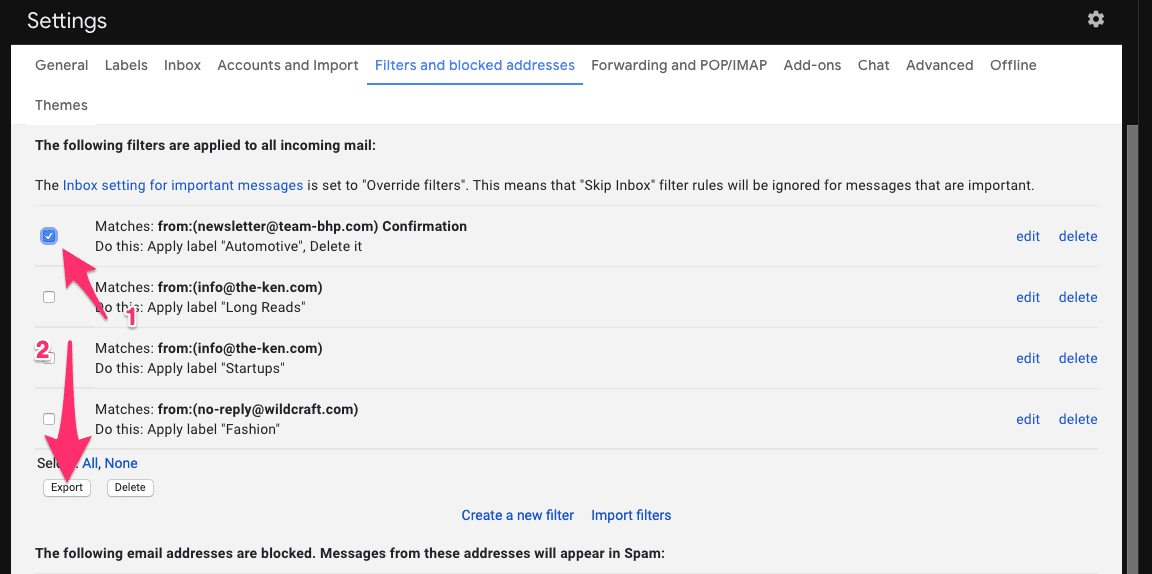
Clicking on ‘export’ generates an XML file.
This XML file can then be edited via a text editor or saved and imported into another Gmail account in order to replicate the filter setup.
To import a filter, once again use the gear icon→settings→filters and blocked addresses path to get to the list of all your existing Gmail filters.
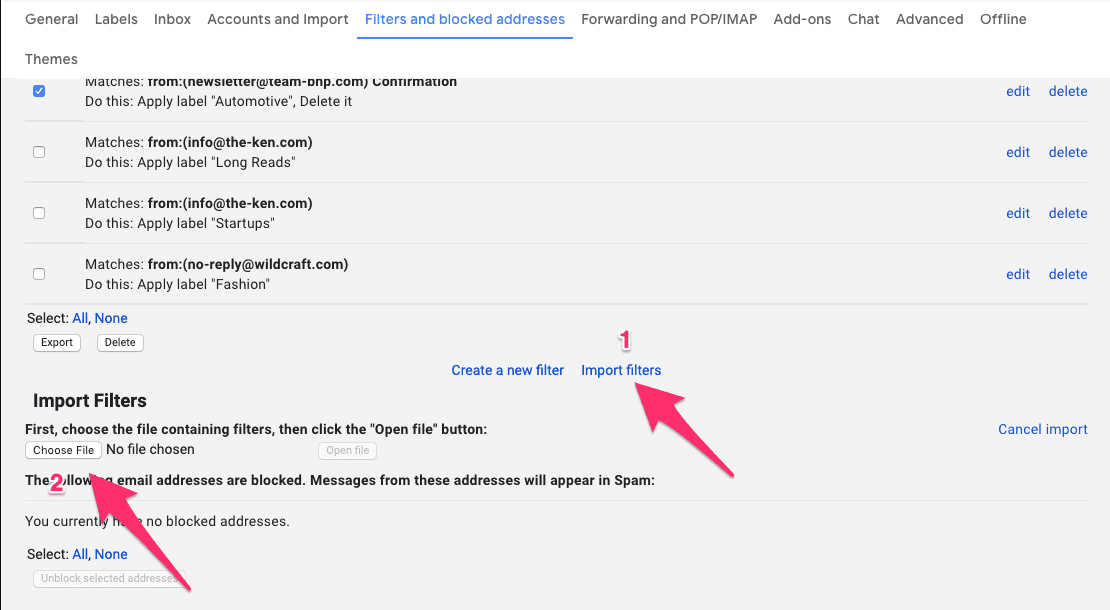
Click on the ‘import filter’ option, then upload your XML file.
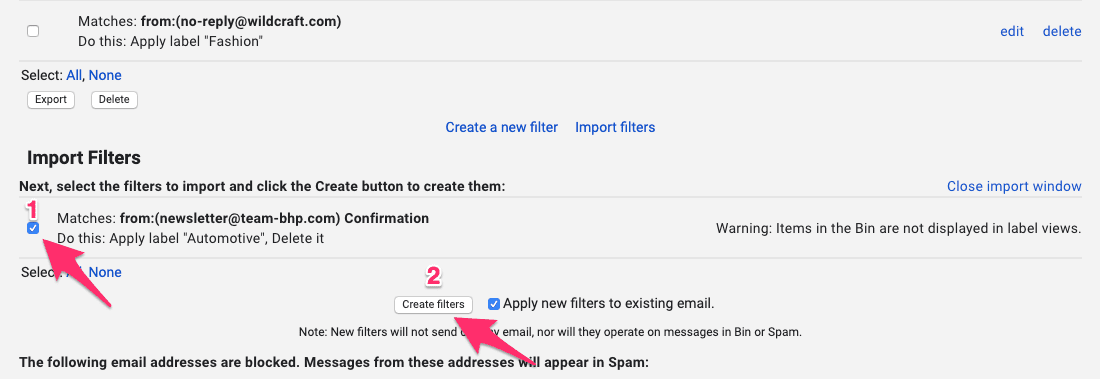
Now click on the checkbox next to the imported filter and use the create filter option to start using the newly imported filters.
Congratulations! You’ve graduated from the Gmail filter school. Now on to some must-have Gmail filters to achieve inbox nirvana.
More ways to organize your inbox
1. Use the ‘+’ trick for alias email addresses
Gmail allows you to create email aliases by adding a plus sign (+) and a keyword after your username in your email address (e.g., [email protected]). This trick ensures you aren’t publicly sharing your primary email address.
For example, you can sign up for newsletters using [email protected]. Then, create a filter in Gmail to automatically label or archive these emails, keeping your primary inbox clear.
Recommended Reading: What are Google Workspace Email Aliases and How to Use Them?
2. Create action-based labels
Organize your emails based on the action required. Create labels such as “To-Do,” “Follow-Up,” and “Waiting For Response” to keep track of tasks and ongoing communications. You canapply the “To-Do” label to emails that require action and review this label regularly to ensure tasks are completed. If emails need a response later, move them to the “Follow-Up” label.
Recommended Reading: Gmail Labels: Everything you need to know
3. Set up automatic replies
If you’re going to be away or unable to respond promptly to emails, you can set up an Out of Office AutoReply. This feature automatically informs people that you won’t be able to respond immediately. When someone sends you a message, they’ll receive an automatic response that conveys that you’re not at your desk and sets the right expectations for when they can expect a response.
How to set up:
- Open Gmail on your computer.
- Click “Settings” in the top right corner and select “See all settings.”
- Scroll down to the ‘Out of Office AutoReply’ section.
- Turn on ‘Out of Office AutoReply’ by selecting the appropriate option.
- Enter the date range, subject, and message for your reply. If you want only your contacts to receive the Out of Office reply, check the box below your message.
- Finally, click “Save changes” at the bottom of the page.
Recommended Reading: How to Write An Automated Email Response: Tips & Examples
4. Use email management tools
Filters are great for sorting emails, but what if you want to collaborate with your team or delegate an email as a task to a colleague? That’s where a tool like Hiver can help.
- Shared Inboxes for Team Collaboration: Hiver allows you to create shared inboxes for team email accounts like support@, sales@, or info@. This feature ensures that all team members can access and manage these emails efficiently, reducing the chances of missed emails and duplication of work.
- Email assignment and delegation: When any new email reaches the shared mailbox, it appears in the ‘Unassigned’ view of the shared mailbox for all the users. With Hiver, you can automatically assign emails to specific team members using predefined rules—such as sender, subject line, or keywords. This ensures that the right person handles every email. Cutting down on the time spent sorting through the inbox and manually distributing tasks.
- Internal notes for collaboration: Hiver lets you add internal notes to emails, which are visible only to your team members. This feature is perfect for discussing how to respond to complicated emails or sharing important information related to a specific email. For example, if an email requires input from multiple team members, you can use internal notes to communicate within the email thread without cluttering your inbox with additional messages.
- Automated workflows: Hiver allows you to create automated workflows that perform specific actions on incoming emails. These workflows can automatically apply tags, assign and close emails, or trigger notifications based on criteria you define. For example, when an email thread has been addressed, Hiver can automatically close it, helping you keep your inbox focused on active, unresolved items. This reduces clutter and ensures that your attention is directed where needed most.
- AI Summarizer: By providing summaries, Hiver’s AI summarizer tool helps prevent your inbox from becoming overloaded with unread emails. You can quickly process and archive threads, keeping only those that need further action in your inbox, which helps maintain a clean and organized workspace.
Conclusion
Gmail filters are, without a doubt, the easiest and most effective way to organize your inbox and reduce clutter. Whether you want to prioritize important emails or take care of spam effectively, you can set up multiple filters depending on your priorities.
However, as the volume of emails you receive and the need to collaborate with your team on these emails increase, things become more complex. Filters won’t help you coordinate responses over email or keep track of an email you’ve delegated to someone else.
This is where Hiver comes in.
Hiver enhances the capabilities of Gmail filters and elevates your overall email management experience. Take this interactive tour to see how Hiver can help you organize your inbox.

































